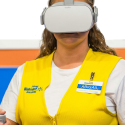
In the good old days, a fashionable window display could be all it took to get a customer to saunter into a store.
Today’s connected consumers are not won over so easily.
READ NEXT

Kellogg pilots VR eye-tracking in simulated stores
While digital stores are steadily gaining traction the world over, brick and mortar stores are at somewhat of a crossroads. How do you offer consumers an experience that they can’t get online?
The obvious place to look for disruption is with emerging technologies and, of course, virtual reality (VR) and augmented reality (AR) are by no means an exception.
In fact, most big brands— including Audi, Uber, Macy’s and even the New York Times— have engaged with the technology at one point or another, given bullish predictions that the VR market was ready to boom.
While that hasn’t exactly happened, VR and AR technologies still offer tantalizingly untapped potential to provide a new experiential layer to the shopping experience, if integrated seamlessly as a useful component of the consumer’s buying journey.
In 2017, Swedish furniture maker IKEA launched an AR app that would allow customers to visualize a piece of furniture in their own living room, helping them to get an idea of whether products would fit and match the room.
US department store Macy’s, meanwhile, launched a VR furniture shopping experience in 70 of its stores, allowing shoppers to design a living space with 3D furniture images.
But applications are relatively untethered; fashion retailers or makeup brands could let consumers ‘try on’ items; car makers can let customers virtually test-drive a new model; sports brands can let consumers design a customized pair of sneakers in-store.
Dogging these experimentative outings of the technology, however, has been the question of whether the use of this technology is a gimmick. Is it truly offering customers extra value to their purchasing experience, or is it just the use of technology for technology’s sake?
It’s a question that’s compounded by the International Data Corporation (IDC) finding that shipments of AR and VR headsets plunged as much as 30.5 percent year-over-year between 2017 and 2018.
According to management consultancy firm Accenture, however, this downwards trend is not one it expects to continue in 2019, and this is partly because a certain type of VR and AR hardware is getting both cheaper and easier to use.
“We’re seeing a number of standalone devices that don’t need to be attached to PCs or phones hit the market, which we expect to be a key driver for increased adoption in 2019,” said the firm’s XR lead Divya Sampath.
“We’re also seeing an improvement in user experience, as well as the content that is available, which should further drive usage and growth.”
According to IDC, in 2020, standalone AR and VR devices— such as Facebook’s Oculus Go and Oculus Quest, which can be bought at retail prices of US$200 and US$400— could account for a combined 54 percent of the market.
As the name suggests, this tetherless hardware doesn’t require additional equipment, such as screens, a smartphone, or wired power supplies, allowing for mobility and ease of use anywhere, including in-store.
YOU MIGHT LIKE
Can VR help Walmart better train one million employees?
CEO and creative director of Trigger, Jason Yim, meanwhile, predicts that ‘WebAR’ will become a standard across browsers, presenting consumer access to ‘light’ AR features on web pages or social media without downloading an app. Technology which could be advanced by 5G.
For AR and VR technology to become successful in retail, and to move beyond novelty status, the onus is on making the technology as easy to use as possible— nobody particularly wants to be going out of their way in-store to a special zone to use a wired VR headset, for example, or waiting for an app to download on their smartphone.
It’s worth noting, though, that these technologies don’t have to be in direct contact with the customer for the benefits to be felt by the retailer or brand deploying them.
Last week, food manufacturer Kellogg Company and Accenture teamed up to pilot the use of eye-tracking VR technology to inform merchandising, or shelf-stocking, decisions.
Users can move through the virtual space, shop, and pick up products and place them in carts, while eye-tracking data analytics, meanwhile, allows for monitoring of what consumers are looking at, for how long, and why.
Early results of the tie-up showed placement on lower shelves to be 18 percent more effective than on higher shelves, where it was thought consumers expected to find new products. It would also allow retailers to conduct market research faster in more geographically disperse locale.
While AI and VR is being deployed to add directly to a consumer’s experience, or behind the scenes as a new source of insights, the real question retailers should be asking is what is the differentiating value that the technology brings?

